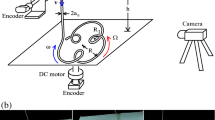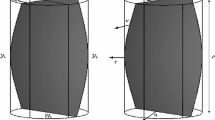Abstract
We present the results of the combined experimental and theoretical investigation of rope coiling arising from the buckling instability. The shape of the rope is perfectly circular in the coiling region and is straight in the region below the feeding point. In between these two distant regions, the rope assumes a catenary-like shape in the limit of slow feeding velocity and a helix-like shape in the limit of fast feeding velocity. When there is an increase in the feeding velocity, the transverse displacement of deformation persists over the long distance far beyond the coiling region. The catenary is associated with the purely imaginary wave number and the helix is associated with the real wave number. The catenary-to-helix shape transition is particularly evident when the rope is fed from a large height.









Similar content being viewed by others
References
A A Travers and J M T Thompson, Phil. Trans. R. Soc. Lond. A 362, 1265 (2004)
A R Singh, D Giri and S Kumar, Pramana – J. Phys. 71, 283 (2008)
C W Wolgemuth, T R Powers and R E Goldstein, Phys. Rev. Lett. 84, 1623 (2000)
M A Dias, L H Dudte, L Mahadevan and C D Santangelo, Phys. Rev. Lett. 109, 114301 (2012)
Y Kantor, Pramana – J. Phys. 64, 1011 (2005)
D M Raymer and D E Smith, Proc. Natl. Acad. Sci. 104, 16432 (2007)
E Bayart, S Deboeuf, F Corson, A Boudaoud and M A Bedia, Europhys. Lett. 95, 34002 (2011)
J L Silverberg, R D Noar, M S Packer, M J Harrison, C L Henley, I Cohen and S J Gerbode, Proc. Natl. Acad. Sci. 109, 16794 (2012)
A C Callan-Jones, P T Brun and B Audoly, Phys. Rev. Lett. 108, 174302 (2012)
L Mahadevan and J B Keller, SIAM Rev. 41, 115 (1999)
E Cerda and L Mahadevan, Phys. Rev. Lett. 90, 74302 (2003)
H King, R D Schroll, B Davidovitch and N Menon, Proc. Natl. Acad. Sci. 109, 9716 (2012)
N M Ribe, M Habibi and D Bonn, Annu. Rev. Fluid Mech. 44, 249 (2012)
M Pineirua, M A Bedia and S Moulinet, Europhys. Lett. 104, 14005 (2013)
M Habibi, N M Ribe and D Bonn, Phys. Rev. Lett. 99, 154302 (2007)
M K Jawed and P M Reis, Extreme Mech. Lett. 1, 76 (2014)
L Mahadevan and J B Keller, Proc. R. Soc. Lond. A 452, 1679 (1996)
S S Antman, Nonlinear problems of elasticity (Springer, Berlin, 2005)
L D Landau and E M Lifshitz, Theory of elasticity (Pergamon, Oxford, 1970)
N M Ribe, Proc. R. Soc. Lond. A 460, 3223 (2004)
M K Jawed, F Da, J Joo, E Grinspun and P M Reis, Proc. Natl. Acad. Sci. 111, 14663 (2014)
S W Morris, J H P Dawes, N M Ribe and J R Lister, Phys. Rev. E 77, 66218 (2008)
R Bandyopadhyay, Pramana – J. Phys. 81, 3 (2013)
Acknowledgements
The author is grateful to M Fuangfoong and C Pattamaprom for useful discussion. He is indebted to P Pharob and N Teerachtragoon for the machine-shop assistance, and to P Srinukool for the measurement of the Young’s modulus. He also gratefully acknowledges an anonymous reviewer for the constructive comments and invaluable suggestions. This work has been supported by the DPST-graduate start-up research grant, contract number 24 / 2557, and by the TU new research scholar, contract number 4 / 2557.
Author information
Authors and Affiliations
Corresponding author
Rights and permissions
About this article
Cite this article
Amnuanpol, S. Rope coiling. Pramana - J Phys 89, 69 (2017). https://doi.org/10.1007/s12043-017-1470-4
Received:
Revised:
Accepted:
Published:
DOI: https://doi.org/10.1007/s12043-017-1470-4




